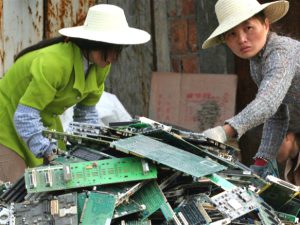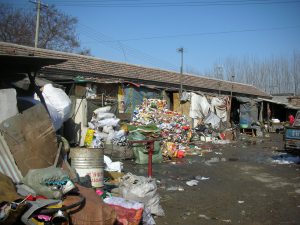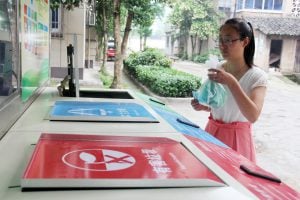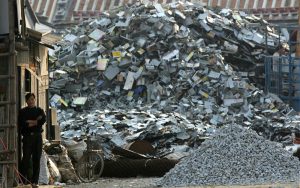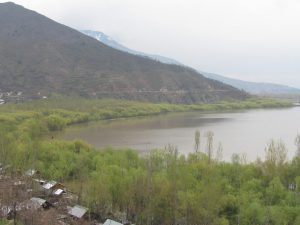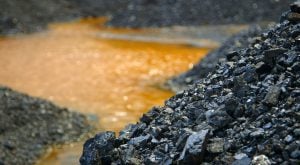To boost their own recycling, most countries are largely dependent on China’s massive reprocessing industry, so an announcement of restrictions on waste imports has left global recyclers reeling.
In a formal notification to the World Trade Organisation (WTO), the Chinese government said that it had found “large amounts of dirty waste or even hazardous wastes” mixed in with imports, and that it would forbid the import of certain types of waste by the end of the year. The list of restricted wastes includes some types of scrap plastics, mixed paper, waste wool, ash, cotton and yarn.
China and the Hong Kong Special Administrative Region import vast quantities of waste from around the globe, including more than 70% of the world’s waste plastics and 37% of the world’s waste paper in 2015, according to data from UN Comtrade. European countries and the US are the main exporters.
In the past, China was less discriminating in the quality of imported waste. China produced 15% of the world’s plastic in 2009, rising to 28% in 2016, according to data from trade body Plastics Europe. However, without a domestic supply of waste for reprocessing, the country relied on recyclable waste from other countries to supply its industry. The economics were also favourable because countries could ship recyclable waste back to China in the same containers used to import manufactured goods.
But as the country has developed a domestic supply of waste, and at the same time come under increasing pressure to clean up industrial pollution, it has become fussier about what it will accept from other countries. Operation Green Fence, which started in 2012, targeted contaminated recyclable waste through inspections of waste shipments.
The operation has been credited with driving improvements in recycling processes and facilities in countries that had no choice but to continue to send waste to China. Simon Ellin, chief executive of the Recycling Association, said: “It absolutely drove improvement in quality by creating more of a buyers’ market. If it wasn’t good enough, they’d send it back.”
Final call for quality or outright ban?
A new clampdown started earlier this year. Under operation National Sword, all containers of waste entering Chinese ports are inspected either manually or using x-ray technology. Recycling companies reported backlogs at ports but material was still being accepted if it met quality criteria.
Commentators from the recycling industry are unsure if the latest government announcement is just an extension of National Sword or heralds a full ban on imports.
Jakob Rindegren, recycling policy advisor at UK trade body the Environmental Services Association, said: “It is still unclear whether the ban would be unconditional or allow materials meeting stricter quality limits.”
Similarly, Ellin believes that the wording of the WTO filing is too vague to indicate an outright ban. “This takes National Sword one step further. It is a final signal that materials have to be absolute best quality,” he said.
However, US organisation the Institute of Scrap Recycling Industries (ISRI) was more dramatic in its reaction, calling the impact of the move “devastating” and “catastrophic”. The US exported more than US$5.6 billion of scrap commodities to China in 2016, a trade which ISRI said was “of critical importance to the health and success of the US based recycling industry”. A ban on scrap imports would result in the loss of tens of thousands of jobs, and closure of many recycling businesses throughout the US, it added.
Similarly, global trade body the Bureau of International Recycling said that while it supported China’s drive for high quality, a ban would be “devastating” for the Chinese and global economy, as well as the environment.
The Brussels-based organisation said it has written to the WTO to point this out, and called on the Chinese government to reconsider the ban and discuss other ways to ensure high quality standards.
Whole supply chain approach needed
Ultimately, the global recycling industry will need to respond by ramping up the quality of waste exports, Ellin said. “We’ve been warning the industry that China is a changed market. As they develop their internal economy and produce more stringent environmental regimes, we need to improve the quality of material that we supply to them for us to remain a preferred supplier.”
Although the industry was driven to boost quality through Operation Green Fence, further improvements will need to include the whole supply chain, including packaging designers, local authorities and households. “Local authorities have been incredibly slow to respond, as have manufacturers and retailers,”’ he said. “They just pass the buck along to our industry, who are expected to create a fantastic product out of rubbish. But if we are to get to this next stage then the supply chain will need to take responsibility and help us.”
Costas Velis, lecturer in resource efficiency systems at the University of Leeds, said an outright ban on imports of plastic waste would have huge implications for other countries. “The problem at the moment is that this is a push market – we’re collecting the material because of mandatory recycling targets. We need instead to create a pull market, to create a need for this material. And this cannot happen overnight. We need to fix prices to make secondary material more attractive, without this, I cannot see how the demand will be created.”
Two plastic bottle reprocessing plants in the UK went out of business a couple of years ago due to the low oil prices, which made competition with virgin plastic very hard, he pointed out.
“Maybe this time of crisis is a major opportunity to reconsider what we collect, why we are collecting it, what it costs and to whom,” he said.

